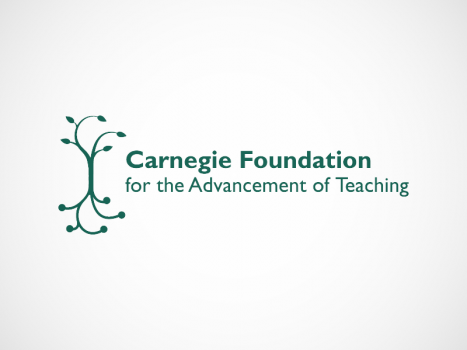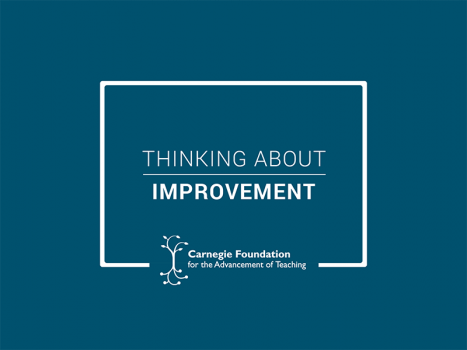Continuous improvement organizations are not common in the field of education, but a few organizations have initiated improvement methodologies borrowed from methods that have been used in other fields and found them to align well with efforts to improve teaching and learning outcomes.
The vibrancy and dynamism that characterize continuous improvement stand in stark opposition to the approach to improvement in many schools today. Standards-based reform and teacher accountability systems typify the field’s approach to improvement – large-scale, top-down interventions largely devoid of clearly articulated pathways for improvement.
Continuous improvement presents a new approach to work that is not about being “soft.” It brings accountability to the system and offers a tested framework and rigorous methodology for advancing the work of teaching and learning. It taps the wisdom of the members of the entire organization and empowers them to systematically move toward better learning outcomes for all students. In particular, continuous improvement empowers members of the system to grapple with the underlying complexity in schools to undertake the steady work required to catalyze and sustain improvements.
It taps the wisdom of the members of the entire organization and empowers them to systematically move toward better learning outcomes for all students.
Carnegie’s Advancing Teaching-Improving Learning program hosted a convening of experts in continuous improvement methodology to understand what it takes to approach improvement efforts in the K-12 space in this way. We identified four essential organizational conditions for continuous improvement to take root and thrive: constancy of purpose, a culture of improvement, standard work, and quality improvement methodology.
1. Constancy of purpose: describe and maintain coherent, student-focused vision and consistent action over time
Continuous improvement requires a widespread and unwavering commitment to improvement that is robust to the vicissitudes of leadership changes, policy shifts, and short-term incentives. Continuous improvement is a disciplined approach to sustained, iterative innovation that aggregates over time into system-wide transformation. Such transformation depends on a clearly articulated organizational purpose and a relentless commitment to this purpose. A long-term purpose fosters a culture of stability within which small-scale innovations can be tried, tested, and spread. It is the primary obligation of leadership to generate, promote, and pursue this purpose.
Example Practices
a. Define organizational values. Create a set of values and communicate values system-wide.
b. Define district goals that embody these values, and then identify a subset of high-leverage goals to turn into long-term S.M.A.R.T. aims (specific, measurable, attainable, relevant, and time-bound).
c. Focus on critically important initiatives. Reduce the number of initiatives to manageable level for each department and campus. As a rule of thumb, halve the number of initiatives at each site.
d. Create a measurement system to actively measure and monitor progress toward the aims.
e. Align district and campus resources (leadership effort, staff time, money, political capital, etc.) to support the aims.
Improvement requires change, but psychologically, embracing change is hard.
2. Culture of improvement: Build and support shared responsibility for improvement toward the organization’s purpose throughout the organization
Improvement requires change, but psychologically, embracing change is hard. Research calls the human tendency to resist change a status quo bias, a cognitive preference for ways things have always been. Systematic barriers carry a great deal of institutional inertia, and changes to tackle pernicious problems at the heart of teaching and learning require deep will and effort. But such change requires us to release the familiar, opening ourselves up to ambiguity and vulnerability. Embedding continuous improvement into an organization requires a profound culture shift. In contrast to a culture of top-down mandates, in a culture of improvement all members of an organization are committed to advancing the best interests of its students, and leadership ensures the conditions that enable all members to make improvements at all levels of the organization to achieve that end. Such a culture requires a shared sense of mission, transparency, trust, innovation, collaboration, and an orientation to learn from failure, not punish it.
EXAMPLE PRACTICES
a. Assemble a leadership system to launch and sustain cultural transformation toward the organization’s purpose.
- Secure the support of the school board and elements of the business community to accept that systems, not individuals, are responsible for the vast majority of problems observed.
- Ensure senior leaders model their improvement orientation in their own work including sharing data about improvements based on their own leadership.
- Utilize social media to “market” the process improvements and positive changes in the organization.
b. Empower members at all levels of the organization — from classroom to board room to iteratively improve.
- Anticipate early resistance to this new approach — identify and enlist the support of building-level leaders.
- Generate ideas for process changes close to where they occur. Workers engaged in the processes are best suited to identify opportunities for improving their day-to-day work. Recognize the pride workers take in doing their job well.
- Capitalize on members’ intrinsic motivation, desire to learn, creativity, and joy in accomplishment.
- Include process improvement as a part of all job descriptions.
- Hire for values and do not accept behaviors inconsistent with values. Human resource functions are aligned to the new culture change, including hiring, on-boarding, training, evaluation, succession planning, and reward and compensation plans.
- Design learning plans for all staff to build up capabilities to engage in improvement work.
c. Design for collaboration.
- Provide structured opportunities for members to work together to improve common processes.
- Share team reports widely throughout the organization.
d. Recognize and celebrate improvement and lessons learned.
- Document and spread improvement in work processes.
- Make improvement work, inclusive of both data and student stories, visible throughout the organization (e.g., in classrooms, hallways, on websites).
- Distill and disseminate learning from both successful and ineffective improvement efforts.
Each system component typically has its own aims, which may or may not be well-aligned to support the district’s aims.
3. Standard work: Define the organization as a system of interrelated evidence-based processes
The work of schooling involves a complex set of funding streams, departments, schools, programs, services, and initiatives, all with their own set of coordinated and interrelated processes. Each system component typically has its own aims, which may or may not be well-aligned to support the district’s aims. Frequently, district members, both at the district and school levels, work in isolation and do not understand the relationship of their work to the work of others. One of the first steps a district can make toward continuous improvement is to draw a process map, or flow diagram, to show how each component depends on others. Indeed, the act of process improvement presupposes the ability to map, or “see”, processes and the relationships between multiple work processes. Documenting processes reveals interdependent processes, but also serves as the baseline for continuous improvement. Standard work:
- Precisely describes the most efficient and effective way known to perform a particular task or process to achieve the desired end result,
- Becomes the norm for how the task or process is executed throughout the organization, and
- Is expected to be continually improved.
After a particular process is improved, the new process becomes the baseline for further improvements.
Example Practices
a. Map the processes for core district work – both the learning and the related support services.
b. Create and implement methods and tools to gather stakeholder feedback on the mapped processes, include feedback from students, faculty, parents, community members, etc.
c. Engage in explicit alignment activities in order to codify best practice in key operational functions.
d. Develop a process to train others on the district’s standard work.
e. Collect stories of what works and codify that into knowledge products — “changes that work”. Post artifacts and best practices on a common website location available to all district personnel.
f. Use coaching support to adapt best practices to local context.
g. Execute well-articulated and well-understood processes consistently.
Continuous improvement provides a set of tools and methods that, if used with integrity, can accelerate a district’s capacity to improve
4. Quality improvement principles and methods: Sustain a disciplined approach to daily data collection, theory development, and hypothesis testing to improve processes
Often the least well-understood aspect of continuous improvement is the methodological rigor it demands. Continuous improvement provides a set of tools and methods that, if used with integrity, can accelerate a district’s capacity to improve. In contrast to large-scale reform approaches, changes are informed by a clearly defined theory of action, and designed and tested over time. Importantly, the changes are thoroughly tested to determine whether they indeed represent improvements. Additional tests refine and build confidence in the changes before they are applied on a wider scale. A hallmark of continuous improvement organizations is the improvement project. In recognition of the interdependencies of processes within complex systems, continuous improvement organizations identify a process in need of improvement and endorse an improvement team (i.e., members from different roles who are familiar with the different aspects of that process) to work together toward this end. Each improvement team has an executive sponsor who takes responsibility for the success of the improvement project.
EXAMPLE PRACTICES
a. Develop and execute an improvement capability plan throughout the organization.
- Define quality and continuous improvement in terms that make sense to all stakeholders.
- Develop a common improvement methodology and vocabulary system wide.
- Train workers at all levels of the organization in the selected improvement approach.
- Implement improvement coaching as a core part of adult learning support.
- Articulate core district aims and a process for setting local project aims that are aligned.
- Identify and map core processes associated with important project goals. Develop and use process measures that show how teaching and learning is being done.
b. Test changes in improvement teams.
- Carefully select initial sites for testing ideas, learning, and sharing what works to create high likelihood of early success (e.g., choose test sites with broadly trusted campus or administrative leaders).
- Create formal project charters with clear intent, aims, and deliverables.
- Identify improvement team members to fill specific roles (sponsor, process owner, team lead, team members, and subject matter experts).
- Train team members on appropriate roles and tools for improvement.
- Allocate resources to achieve the aims of each team charter.
- Document tests using tools of improvement (e.g., PDSA documentation, run charts) that support discerning if a change is an improvement.
- Schedule system level reviews of improvement projects.
c. Design a system to spread ideas that work.
- Articulate a formal testing framework to implement initially successful changes at new sites.
- Document adaptations required to make change successful in new sites.
- Develop a package of successful adaptations to document the important aspects of context sensitivity.
December 11, 2013
In its second year, Carnegie’s Community College Pathways program sustained its high level of student success while also experiencing a growth in the number of students enrolled and the number of campuses teaching Pathways.
March 17, 2014
A 90-Day Cycle conducted at the Carnegie Foundation explored the question of if teacher evaluation and teacher development efforts can and should be combined as aspects of a single system.






